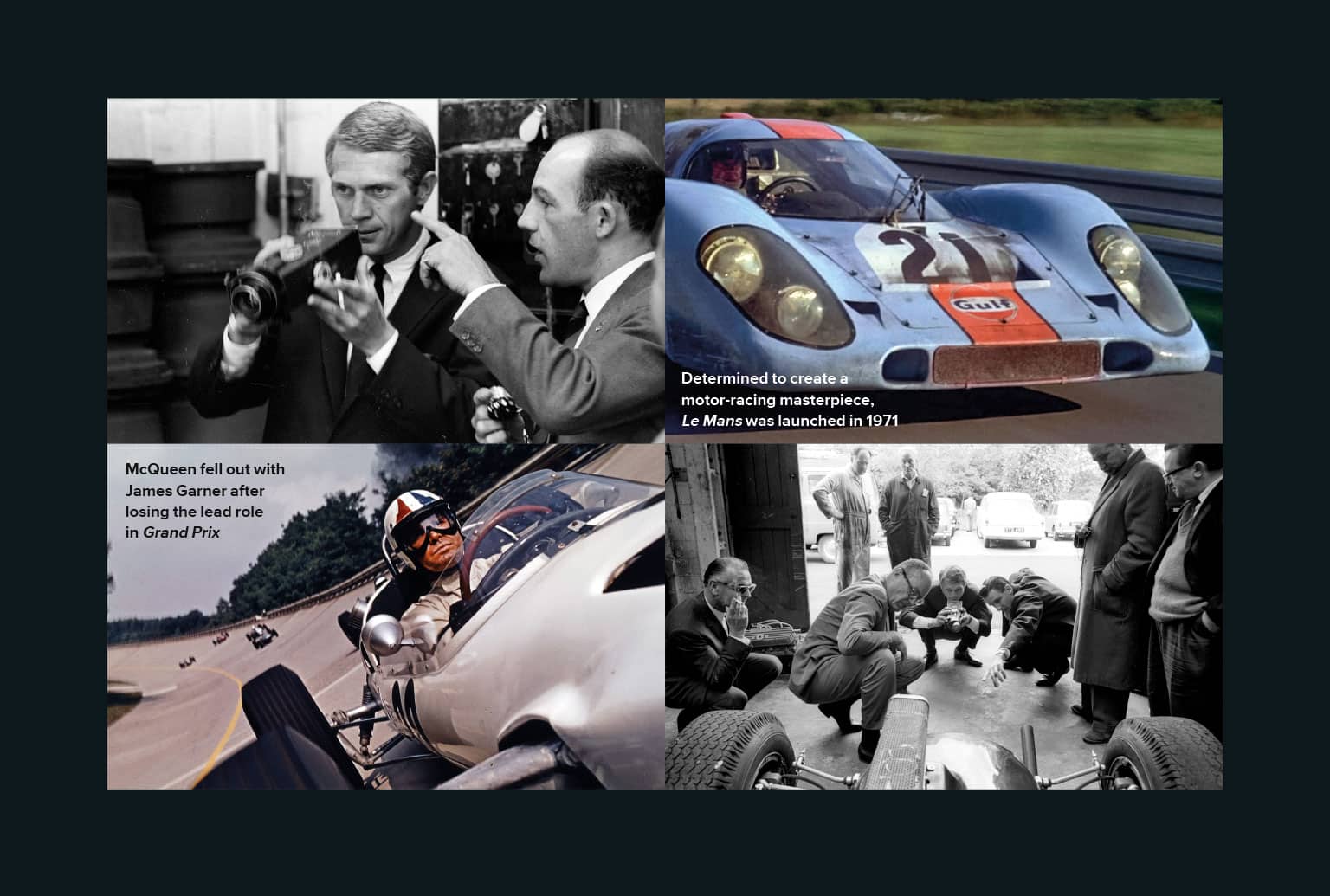Steve McQueen's lost F1 movie: Day of The Champion
Years before filming the seminal Le Mans, Steve McQueen had dreams of making a grand prix epic. The project was axed but as Damien Smith reports, the abandoned and long forgotten early footage has now been rediscovered
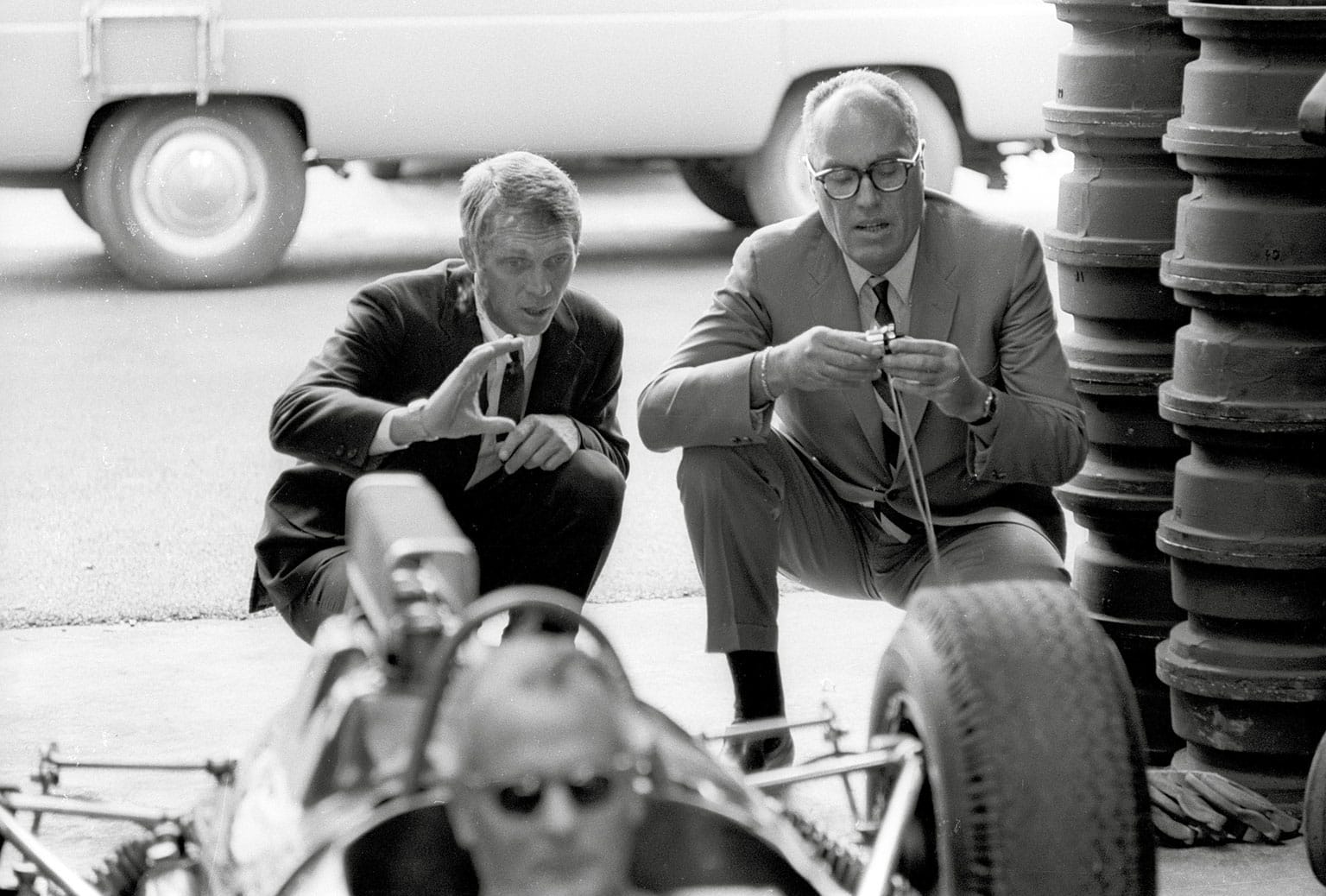
Steve McQueen wanted John Sturges to direct his grand prix film, who he’d previously worked with on The Great Escape. They’re pictured here in the Alan Mann Racing Garages, which is where they flew to immediately after their research at the 1965 Monaco GP
Steve McQueen or James Garner? Michael Delaney or Pete Aron? Hilts ‘The Cooler King’ or Hendley ‘The Scrounger’? You’ll have your preference. John Frankenheimer, director of 1966 motor racing blockbuster Grand Prix, certainly had his – and it wasn’t the star who he ended up with. “I still think if we’d had Steve McQueen in that movie it would have been bigger than Jaws,” he said. That might have stung Garner, had he cared – which he probably didn’t. For the horizontally laconic actor immortalised in motor sport as the ‘other’ world champion of that melodramatic alternative 1966 season, Grand Prix was just another job – even if his own interest in cars turned out to be genuine. But for his friend, neighbour and co-star in The Great Escape, and as it transpired arch celluloid rival, racing was… “life”, as he would come to express it in a certain other racing movie further down the road.
Garner would never have got anywhere near Pete Aron’s blue-and-red-striped Chris Amon helmet had Frankenheimer got his way. But for a fateful meeting with producer Ed Lewis that the director missed, the role would have been McQueen’s. Instead, the famously volatile actor stormed out. But even then, if he wasn’t to be Pete Aron he could still have been Hollywood’s first Formula 1 star, as he wanted to be, far more than Garner. He would have been Michael Pearce, hero of Day of The Champion, the great lost motor-racing movie of the 1960s.
Exactly how ‘great’ it would have turned out to be is open to question, according to those who have read the script… but a stunning new feature-length documentary gives us a glimpse of what we’ve missed for all these years, at least from a racing action point of view. Steve McQueen: The Lost Movie, soon to be broadcast by Sky Documentaries, reveals for the first time just what silver-screen gems were already in the can prior to Warner Bros studio shouting cut before principal filming had even begun. The unseen footage captured at the 1965 German Grand Prix, unearthed as it turns out purely by accident (see sidebar), offers a technicolour (or at least mostly ‘Nürburgring green’) glimpse of F1 that rivals anything Frankenheimer’s Grand Prix captured, and in a manner that offers a tantalising snapshot of an authentic motor racing movie that pre-dates McQueen’s Le Mans by five years.
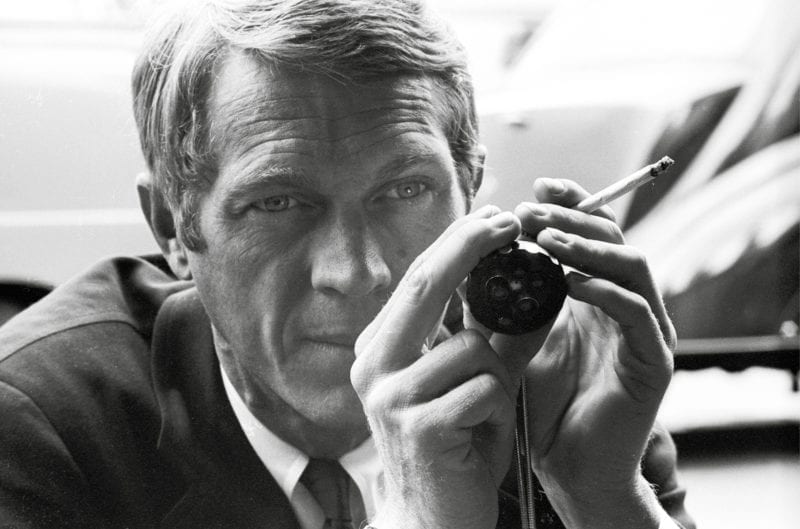
The main character’s name, Michael Pearce, would have been well-known by motor-racing fans today
The premise for Day of The Champion was born directly from the verging-on-unhealthy motor-racing obsession that ate away at the Indiana-born actor in a manner that movies never would or could during his complex and too often troubled life. John Sturges, the great auteur director with whom he’d bonded so firmly during the making of first The Magnificent Seven in 1960 and most illustriously The Great Escape in ’63, was a kindred spirit who seemed to get what McQueen was driving at. He was primed to take the helm. But instead of their crowning glory, Day of The Champion would end in humiliation and frustration, as Frankenheimer and Garner beat them to the punch. As the documentary explains, circumstance, bad luck and movie politics left them sprawled on the canvas.
McQueen was on the top of his game in the mid-60s. Clint Eastwood had Rawhide, Garner had Maverick, and Steve had Wanted: Dead or Alive, the TV western that was his own conduit to a Hollywood movie business struggling to find its place in a fast-changing world. But McQueen was always more interested in cars and motorcycles anyway. In 1961, he travelled to the UK to make a black-and-white war film, The War Lover with Robert Wagner and Shirley Anne Field – but as The Lost Movie explains, with a clear ulterior motive. Shooting on location at RAF Bovingdon and around Cambridgeshire, McQueen just happened to find himself roughly in the same proximity as windswept Snetterton and Jim Russell’s tempting Formula Junior school cars, captured like candy pieces by the British Pathé colour archive.
The documentary includes a wonderful interview with a hirsute McQueen conducted by Anglia Television that offers an insight into the actor’s true love, that borders on the spiritual. “It’s a pure thing. Racing is one of the few things in life you can’t fix,” he says to the plummy interviewer the like of which simply doesn’t exist today. “You can’t buy your way out of it. When you are out there by yourself, you are very much by yourself.”
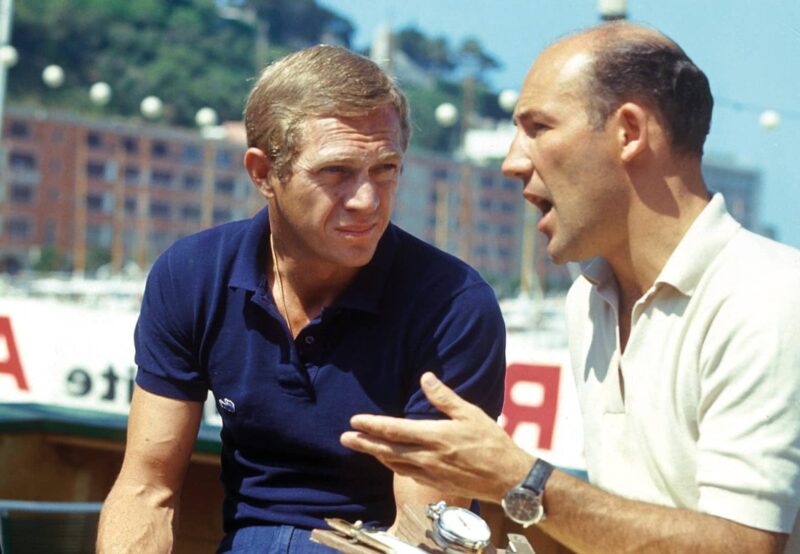
Moss and McQueen talk shop at Monaco
It was during his three months in the UK that McQueen struck up a friendship with Mini racer John Whitmore, who agreed to meet him at a London hotel at the behest of BMC Competitions boss Marcus Chambers. “Steve was staying in the Carlton Tower Hotel, where he used the service lift to avoid being hassled, although few outside America had even heard of him at that time,” wrote Whitmore in the Telegraph in 2004. “We talked the whole evening away. Never before had I met such an engaging, entertaining, raw and alive human being. He had an impatient passion for women, motorcycles and cars.”

As unlikely as it sounds today, Whitmore took McQueen north to Oulton Park to race a warmed-over Austin A40 in a club meeting. More famously, the emerging movie star also raced his new friend’s Mini at Brands Hatch in the final round of that season’s British Saloon Car Championship, coming off third-best in a great scrap with Vic Elford and Christabel Carlisle. The latter is interviewed in The Lost Movie, on a day that must have crimped the actor’s macho ego – not that he let it show when he drove her back to London. “He was charming, chatty – had wonderful blue eyes…” says Lady Christabel Watson as she is today, with more than a glint in her own. “He behaved extremely well.”
That taste of European motor sport would mix with another key ingredient to inspire Day of The Champion. The Cruel Sport by American journalist Robert Daley and first published in 1963, offered a garish and unflinching view of motor racing that was carefully side-stepped by publications such as starchy Motor Sport back then. As journalist Peter Windsor puts it as one of the talking heads in The Lost Movie: “It opened the doors for Steve McQueen to go to Warner Bros and say, ‘This is what I want to make a movie about.’” The seed was sown – or perhaps that should be scattered.
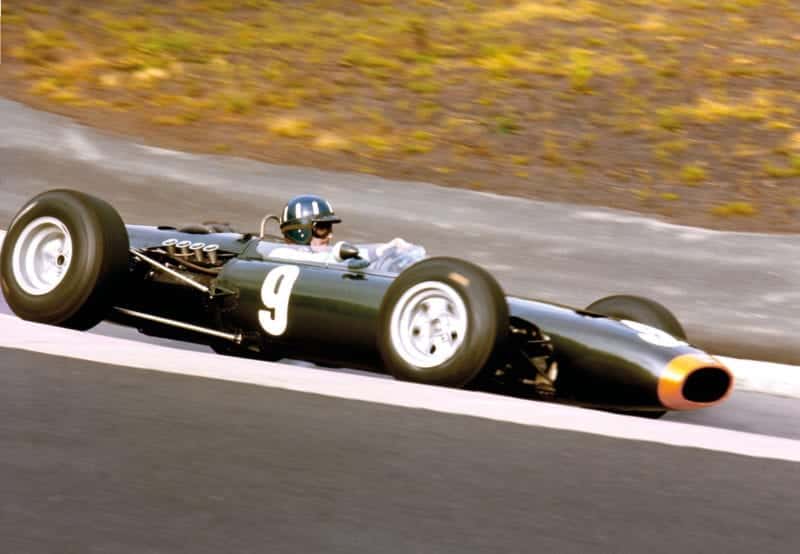
Graham Hill at the 1965 German Grand Prix
Sturges secured what he thought was the exclusive rights to make a film from the book, only to discover otherwise at a movie business dinner, where he found himself sat next to the relatively little-known Frankenheimer – who started to tell him about his plans for a motor-racing movie inspired by… The Cruel Sport. Turns out he’d been dealing with Daley directly. The next day, both Warner Bros and MGM, who had bought into Frankenheimer’s vision, announced oddly similar new motor-racing movie projects.
Shortly after, as described in an archive interview conducted with Frankenheimer in 1998, the “disastrous” meeting with McQueen took place – and Garner landed the role, very much against the director’s wishes. Again, an interview with the man who would be Pete Aron has been unearthed, in which Garner describes the moment he phoned his old Great Escape buddy to break the news. “There was a $20 silence on the telephone,” he says with that familiar Jim Rockford smile. “He didn’t talk to me for about two and a half years.”
But at this point, Sturges and McQueen took pole position in the race to the box office. Awkwardly, both film crews began recceing F1 at the 1965 Monaco GP, McQueen attending the race with guidance from Stirling Moss, who would join Whitmore and ace car preparation specialist Alan Mann as an adviser on the movie. Then later that summer, Moss, Whitmore and Mann headed to the Nürburgring to begin filming at the German GP – which is where this story comes alive.

For 55 years, the rushes from what was shot that weekend have remained stored and unseen – until ace archivist and serial documentary maker Richard Wiseman discovered them by mistake. And here in The Lost Movie they are revealed in all their considerable glory. Vibrant crowd and pitlane scenes, plus the lovely old Nürburgring paddock, are captured on 35mm Eastman Color film. Dramatic track action shot from a helicopter exposes the speed and commitment of the premier-class stars in the final year of 1.5-litre F1. And there after the flag is Jim Clark, race winner and newly crowned two-time world champion, standing on a podium with Graham Hill to his right, Dan Gurney to his left – while in the foreground stands Colin Chapman, looking on benignly without a hint of the high emotion F1 team bosses today can’t resist expressing in such moments. But the best is yet to come.
Now we are on board with Moss at the helm of a Mann-prepped Lola T70 camera car, the cameraman either squashed in beside him to film the rear-view of a pair of Reg Parnell Lotuses ducking and diving between the Nürburgring’s hedges, or looking back at their red-striped noses from a precarious perch on the sports racer’s tail. This is the real Nordschleife, as it was before steel barriers came between the trees, shrubs and ditches. It’s spectacular stuff.
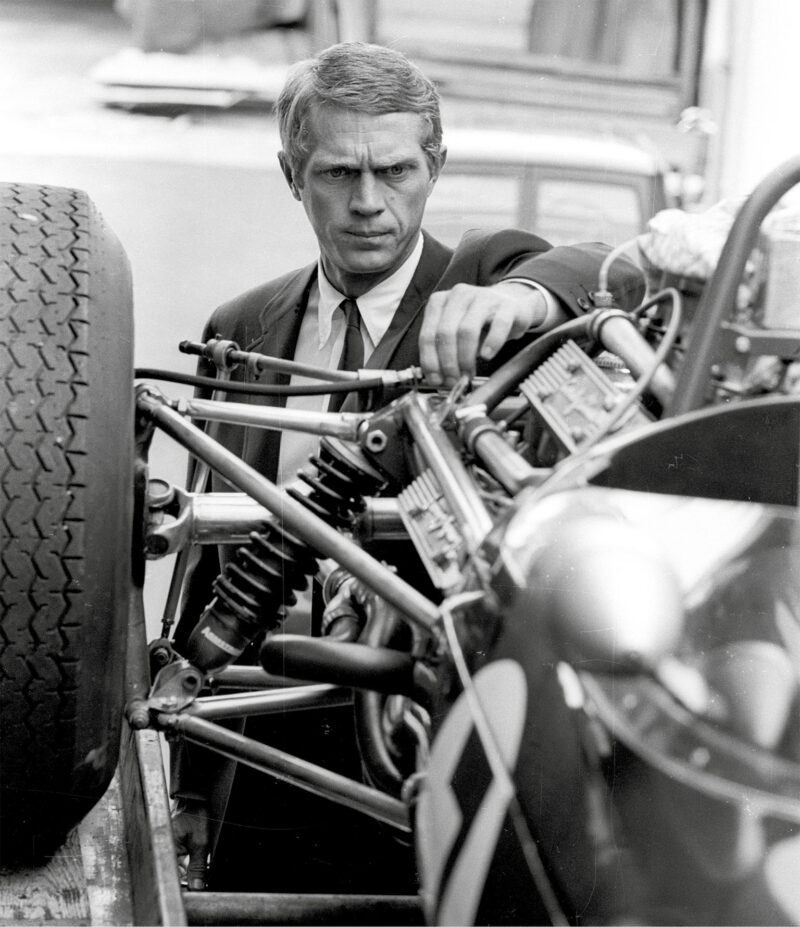
Ultimately, it was not to be for McQueen, but footage of the European race scene in 1965 is historically important
But then comes the real spine-tingler: we’re on Moss’ right shoulder, the familiar Herbert Johnson helmet looking down the snout of a blue Rob Walker Brabham. It’s three years and more since the bank at Goodwood’s St Mary’s rushed up and ended his frontline racing life. Yet here he is, back where he belongs – and darting between the Parnell Lotus duo, he’s clearly beyond the point of acting for the cameras. At this stage, we switch away to the documentary’s talking heads: familiar faces Windsor, Simon Taylor and Nigel Roebuck, all of whom smile as they watch the footage on electronic tablets. Then Roebuck recalls a conversation with Stirling when he reminded his friend of that day of supposed ‘filming’. “He told me, ‘I felt like I did when I won there in 1961,’” says Nigel wistfully. Moss hinted at it himself, but these images only seem to confirm it: the abrupt retirement in the wake of his Goodwood recovery was far too rash. Stirling could still have been at his best in 1965.
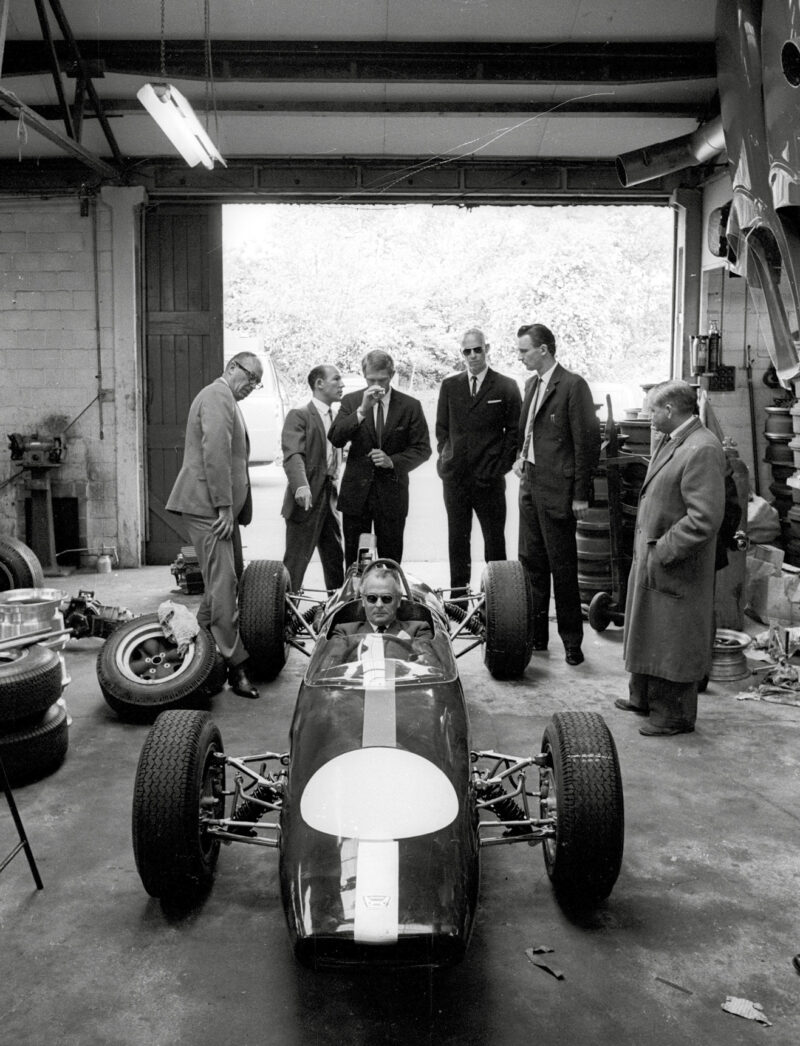
McQueen spent three months in Europe but studio politics would end his dream of a grand prix movie. Here the crew surveys camera mounting positions. At the back from L-R: Sturges, Moss, McQueen, producer Bob Relyea and Phil Kerr, who was one of Bruce McLaren’s right-hand men
Further on, there’s more from Warner Bros’ cameras, at Oulton Park to capture the Tourist Trophy in April 1966. Mann’s camera car and more helicopter shots capture a verdant Cheshire circuit and Hugh Dibley’s Stirling Moss Auto Racing Team (SMART) Lola T70 Spyder painted green. On its rear flank a sticker reads ‘PEARCE’ – Dibley was subbing for McQueen that day for scenes that would never be completed by the man himself. In the snippets of footage unearthed by Wiseman, none feature the actor – because principal filming had yet to begin. And it never would.
Although Day of The Champion grabbed an early lead, Frankenheimer had hardly been sitting on his hands. He attended most F1 grands prix in 1965 to recce for his movie and rounded up many of the current stars, plus Phil Hill, who as America’s first F1 champion inevitably inspired the character of Pete Aron. But there are two notable exceptions: Jimmy Clark and Jackie Stewart sided with McQueen.
Stewart appears in The Lost Movie, and while he’s vague on detail and chronology (c’mon, he is 81), he remembers the key reason why he and his friend signed for The Cooler King: “McQueen was bigger than Frankenheimer.” But as the Day of The Champion unravelled, the Scots lacked no compunction switching sides and pledging their allegiance to Grand Prix. “We got paid twice,” quips Sir Jackie.
During 1965 Sturges found himself struggling with the thorny development of Ice Station Zebra, ironically for MGM, while McQueen was on his way to Taiwan to make The Sand Pebbles, playing a sailor in the US navy caught up in the Chinese civil war of the 1920s. Perhaps McQueen’s most critically acclaimed work, the movie directed by Robert Wise of The Sound of Music, was only supposed to take nine weeks of his time. Instead, it would stretch on for seven months – into the summer of 1966, as Frankenheimer, Garner and co cracked into the heart of Grand Prix.
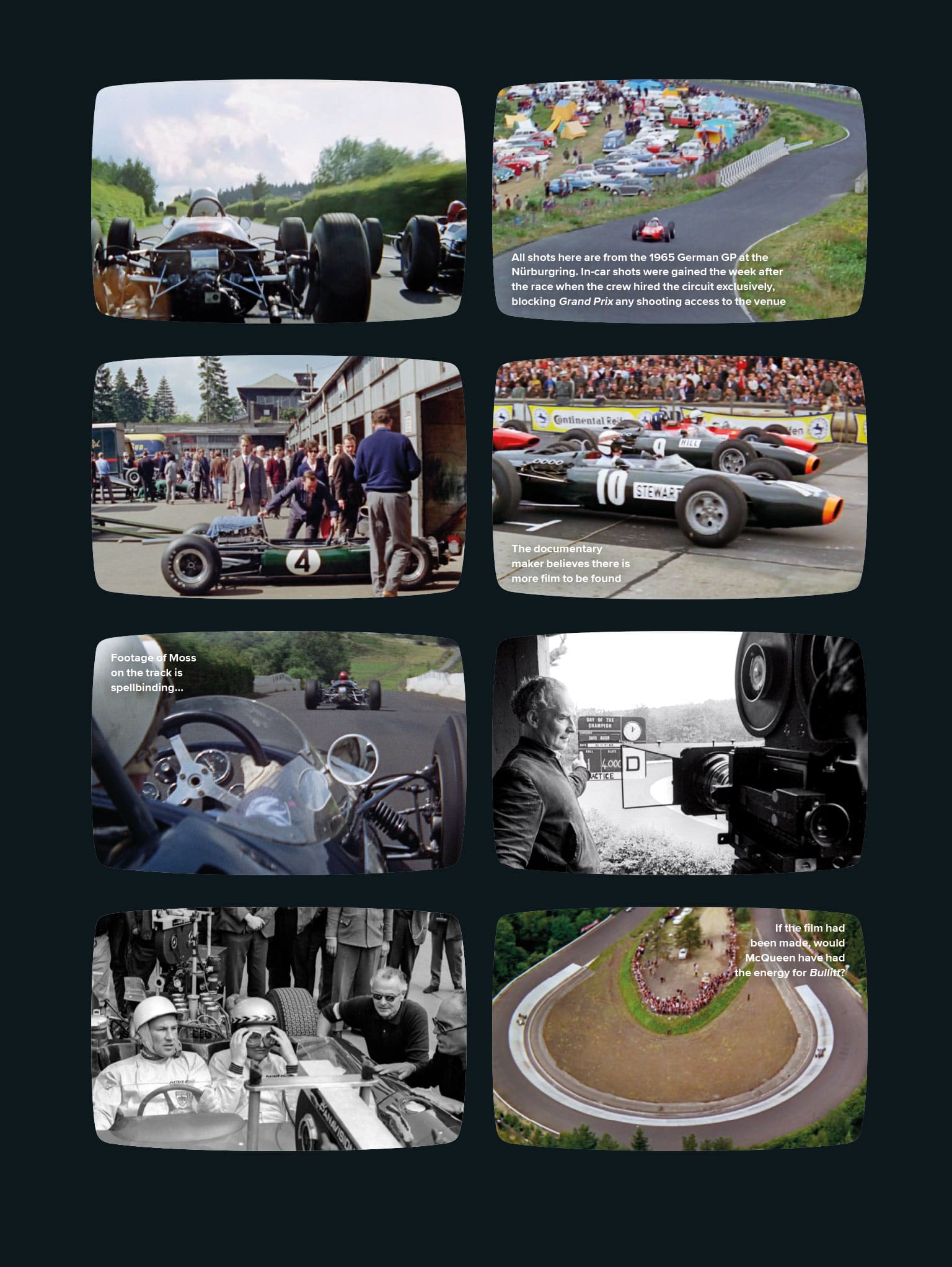
The Lost Movie then offers other treats, taking us on set at Monaco for Grand Prix, during and after the real race. Frankenheimer is frantic as he tries to marshal racing drivers and extras, then organises a podium scene for the victorious Jean-Pierre Sarti – just down the road from where real Monaco GP winner Jackie Stewart is receiving his trophy from Princess Grace. “I was not aware of it,” says Sir Jackie, which in the commotion of what he’d just achieved is probably fair enough.
The most amusing behind-the-scenes clips capture an enraged Garner letting rip with venom at a blazered official who is protesting to the director for the disruption filming is causing for disgruntled locals. No wonder Garner has lost his rag: he’s dripping wet and stone cold, following Aron’s dunk in the harbour… Footage of the hydrogen cannon firing Scott Stoddard’s Jordan up the wall at the chicane and Aron’s sister car into the Med add to the spectacle, then later Garner takes voluminous charge as he and rival Sarti (Yves Montand) prepare for an action sequence at Brands Hatch. At this point, it’s worth noting that Grand Prix doesn’t visit the Nürburgring – that was Day of The Champion territory.
As Frankenheimer’s band followed the F1 circus around Europe, an ill McQueen was seething in frustration, still stuck in Taiwan filming his Chinese civil war masterpiece. Then in July, as Sturges pushed on with pre-production work, they got the dreaded call from Jack Warner: shut the movie down. The studio was fearful that MGM was about to win this race, although archivist Wiseman also reveals Jack Warner had greater concerns than a simple loss of face. He would sell his studio in the autumn and at this point, the size of the deal had yet to be finalised. Too much was at stake, so McQueen and Sturges were spun out.
The Sand Pebbles and Grand Prix were released in the US in the same week, the former receiving the critical acclaim notably lacking for the latter, which received at best a mixed reaction – at least in the media if not at the box office.
Salt was rubbed at the Oscars, when McQueen was among his movie’s eight nominees – all of which were overlooked… while Grand Prix claimed three Academy Awards in technical categories. Then just to really rub it in, young Chad McQueen asked his old man to take him to see the new racing movie everyone was talking about.
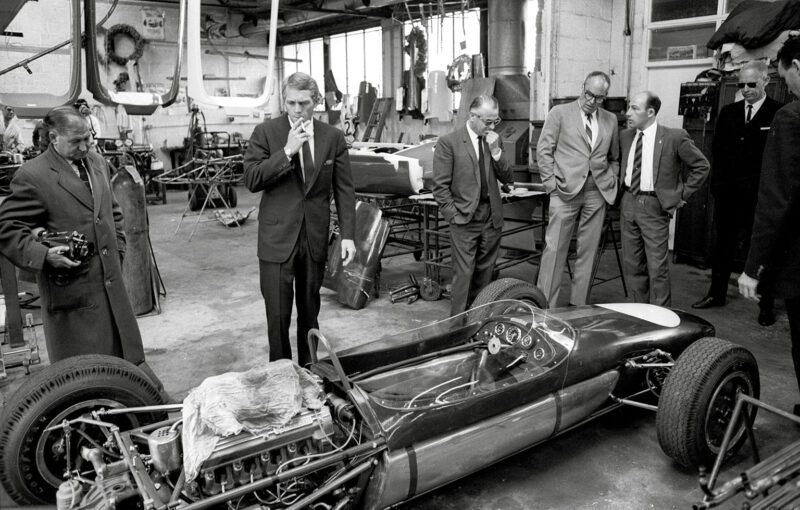
Alan Mann had a clear rule about not smoking in his garages, but clearly nobody was going to tell McQueen…
Today, for all its flaws, Grand Prix stands as a loving ode to a long-distant era of F1, while McQueen’s seminal Le Mans compliments the earlier work and surpasses what Frankenheimer achieved in terms of authenticity – all that really mattered to its star and architect, whose purpose revolved around gaining the respect and recognition of those whose opinion he counted more than anyone: the racers themselves.
As The Lost Movie concludes, echoes of Day of The Champion carried over into its self-indulgent, mesmerising offspring. A version of the signature “Everything else is just waiting” speech can be spotted almost word for word in the script of the movie that never got made. McQueen’s friendship with Sturges and loyal producer Bob Relyea didn’t survive Le Mans, and neither did his own reputation. But as Wiseman says, “Where McQueen was in 1970 was different to where he was in 1965/66. He was a star after The Great Escape, but by 1970 he was the biggest movie star in the world, on the back of Bullitt and The Thomas Crown Affair. He could do what he liked and behave how he liked – and he did.”
Had Day of The Champion made it to the screen on the back of the exhausting shoot for The Sand Pebbles, perhaps neither Bullitt nor The Thomas Crown Affair would have followed – probably greater losses than a hammy movie about this strange sport of motor racing. But thanks to The Lost Movie, at least now we can see the best bits of what went missing.
